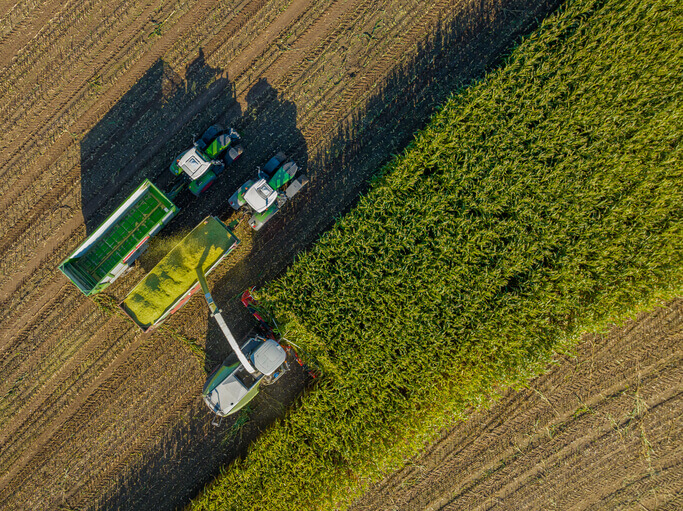Insight Focus
Wheat markets have been highly volatile in 2024. Prices have fluctuated due to varying harvests across regions. Poor yields in Europe contrast with strong production in North America, making it critical for businesses to stay informed on quality and trade flow.
Prices have continued the volatile rollercoaster ride throughout 2024. Reading through countless news reports giving a plethora of information, it can often be difficult to assess what is relevant and what is not to each business. Here’s a quick rundown of the headlines in major wheat geographies.
European Production Lags
The European markets have been most focused on the poor harvests and declining production estimates of the 2024 harvest. The USDA production number for 2023 was 134.87 million tonnes, while the EU Commission has pegged the 2024 harvest at a lowly 116 million tonnes.
The two largest producers France and Germany have reported their worst harvests in 40 and 20 years, respectively.

Source: USDA
As Paris MATIF milling wheat futures are based in France and have a quality specification related to French wheat, this has created delivery issues with the contract. Only 30% of the crop has achieved the MATIF specification of 76kg/hl, while the five-year average is 76%. Find out more about wheat quality here.
The reduced crop leads to Europe having significantly less exportable surplus than normal. Exports so far this season are 4.82 million tonnes, compared with 6.25 million tonnes at the same point last year. Therefore, prices will remain higher, relative to other exporting origins, until there is more faith that stocks can cope with being more competitive in the world export market.

Black Sea Exporters Mull Export Caps
Russia, as the largest wheat exporter in the world, has a much-reduced crop in 2024. The USDA pegged the 2023 production at 91.5 million tonnes, with many current estimates for 2024 falling nearer the 81-82 million tonnes mark. Exports will thus likely fall this marketing year to 44-45 million tonnes versus the USDA figure of 55.5 million tonnes in 2023/24.

Source: USDA
Despite this fall, Russia has been a cheap seller so far and exports are running at a pace to suggest that if this continues, exports will start to slow as we head to the end of 2024 and into 2025. Some are even discussing wheat export restrictions.
Ukraine has a slightly reduced crop but is continuing to make good progress on the export front. It has imposed an export cap of 16.2 million tonnes to ensure adequate domestic stocks.
Bulgaria and Romania, where harvests have been good in 2024, have had to compete with cheap Russian wheat into their Black Sea ports and into mainland Europe. Their exports have made good progress thus far.

North America Harvests at Pace
The US has reaped a promising wheat crop in 2024, with the USDA in August estimating it at 53.93 million tonnes, up from 49.31 million tonnes in 2023.

Source: USDA
This was a big driver of the bearish market sentiment through June, July and the first half of August. The pace of exports thus far at 6.35 million tonnes is faster running than needed. For context, 4.75 million tonnes were exported by the same point last year.
Canada is equally reaping a good harvest with increased production estimated around 35 million tonnes, up from the USDA’s 31.95 million tonnes in 2023.

Southern Hemisphere Enters Mix
With crops in the ground, Argentina and Australia will be especially relevant to the world market into the new year of 2025 once harvests are better known.
Argentina, despite difficult conditions, is looking to grow a decent crop in the range of 18 million tonnes to 21 million tonnes. Either way, this will be significantly higher than the 15.85 million tonnes reported last year, with a record area of 6.3 million ha.

Source: USDA
Australia has got off to a great start with a crop looking to be comfortably over 30 million tonnes, up 4 million tonnes since 2023. Both countries will look to join North America on the export market to make up for the poorer harvests in Europe and the Black Sea for world trade.

The Prices
So, what does all this mean for prices? Wheat values have seen both bearish and bullish periods thus far in 2024, as seen in the charts below.



But global wheat stocks are trending lower — the lowest in almost a decade in fact. Meanwhile, stocks excluding China (which is not an exporter but the largest importer) are the lowest since 2007/08!
Making a Watchlist
As news and numbers pile up in the email inbox, it is important to quickly separate the wheat from the chaff, so to speak. It helps to know what is most relevant to avoid inefficient time-consuming report reading. Some of the factors to be aware of are:
1. Quality
Whatever the position in the food supply chain or other wheat using industries, it is important for a business to understand what type and quality of wheat is needed. The greater your knowledge of wheat specifics, the better your understanding of relevant news for you.
Milling wheat quality has struggled this year for the northern hemisphere’s winter crop in Europe. The spring wheat harvests in North America and the Black Sea are going to be needed to keep a lid on premiums. The results of these are currently not certain given weather issues.
This is compounded by the poorer crops that have been downgraded to feed quality. In some regions, this gives a local abundance of low-quality feed wheat, and a dearth of high-quality milling spec wheat. Premiums will thus be inflated.
2. Location
We have discussed in the distant past that wheat markets do not necessarily move in perfect tandem, dependent upon quality, geography and many other factors. It is therefore imperative for producers, sellers and buyers to know their wheat needs.
It certainly looks like a year of different areas, different issues. The Black Sea and North America are exporting at a good rate. The Black Sea is the cheapest, while the exportable surplus is reduced. This will be something to watch as the year progresses.
North American prices are doing well to stay competitive and compete into the Asian market. The Southern Hemisphere harvest at the end of the year is likely to be relevant if you are a buyer in Asia.
A Watchlist for the End of 2024
- It is inevitable that if stocks are to be replenished, the Northern Hemisphere autumn (which we are approaching) needs to be kind to farmers. A poor planting and establishment of winter wheat prior to any harsh winter will influence the market as we run up to the end of 2024.
- Keep a look out for how planting is going to assess what this might bring for prices as we end 2024 and head into 2025.
- Exporters in some areas need to be extra competitive, as in North America, while others, such as those in Western Europe, need to ensure that they do not become overly competitive. Buyers and sellers should consider geography in their watchlists.
- Look past the present. Carries in the market are big going forward, farmers are not selling in abundance at these levels. Know what this means for any forward purchases or sales.
- Understand any trade flow to your area/region, as North African importers may have a different longer-term perspective than buyers in Asia. While farmers in Europe may see trade factors differently to farmers in North America in the short-term.
- Know your wheat needs and what that quality impact is to you geographically.













